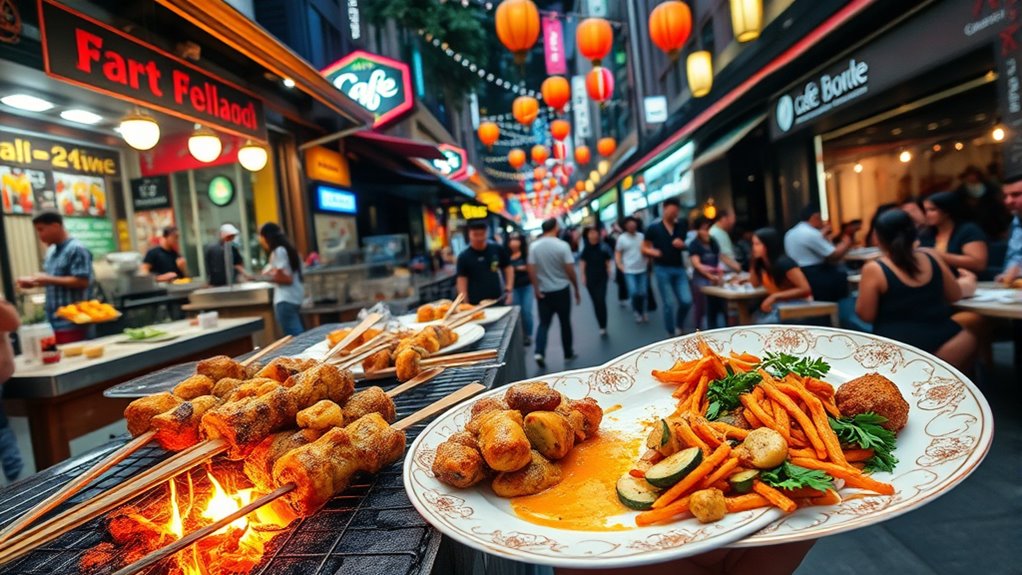You’ll see how street food is evolving from simple warungs into upscale dining experiences by blending tradition with innovation. Chefs and vendors now use advanced techniques, locally sourced ingredients, and artistic presentation to elevate familiar dishes. This movement celebrates cultural roots while encouraging creativity and collaboration. Portable appliances and new flavors make high-quality street food more accessible and exciting. Stay with us to discover more about this innovative culinary shift transforming everyday bites into artful, memorable experiences.
Key Takeaways
- Traditional street food is evolving into upscale culinary experiences through modern techniques and sophisticated presentation.
- Fusion cuisine and innovative methods reimagine familiar dishes, elevating street food to fine dining standards.
- Collaboration between vendors and chefs promotes authenticity, quality, and cultural storytelling in upscale street food.
- Locally sourced ingredients and regional flavors emphasize cultural dialogue while maintaining authenticity.
- Technological advances enable mobility, efficiency, and accessibility, transforming street food into a refined culinary platform.

In recent years, the traditional street food scene has undergone a remarkable transformation as chefs and entrepreneurs elevate simple dishes into upscale culinary experiences. No longer confined to humble stalls or quick bites, street food now stands at the forefront of culinary innovation, blending flavors and techniques to create sophisticated dishes that appeal to a broader audience. This movement is fueled by a desire to honor tradition while pushing boundaries, and fusion cuisine plays a central role in this evolution. By combining elements from different culinary worlds, chefs craft unique flavor profiles that surprise and delight even the most discerning palates. You might find a taco filled with Korean-style pulled pork or a satay skewers served with a modern twist, demonstrating how diverse influences can come together seamlessly on the street.
Street food transforms with fusion and innovation, elevating simple dishes into sophisticated, culturally rich culinary experiences.
This shift isn’t just about fancy ingredients or plating; it’s about reimagining what street food can be. Culinary innovation drives this change, inspiring chefs to experiment with techniques like sous vide, molecular gastronomy, or even plating styles traditionally reserved for high-end restaurants. These innovations allow you to experience familiar dishes in new ways—textures, presentations, and flavor combinations that elevate the street food experience from casual to refined. As a consumer, you’re encouraged to see street food as more than just a quick fix; it’s a vibrant platform for creativity and cultural dialogue. You get to taste the evolution of culinary artistry, often with locally sourced ingredients that highlight regional flavors while embracing global influences.
Moreover, the upscale movement fosters a sense of pride and recognition for street vendors who have long been the backbone of local food scenes. Many chefs now collaborate with these vendors, offering training or sourcing ingredients to elevate dishes without losing their authentic roots. This synergy not only preserves the cultural heritage but also introduces it to a wider audience enthusiastic for innovative yet authentic experiences. As you explore this scene, you might notice how these establishments focus on quality, presentation, and storytelling—all essential elements of fine dining, now accessible on the street.
Additionally, the integration of portable appliances such as portable camping stoves or compact cooking equipment allows vendors to serve high-quality dishes with greater mobility and efficiency, further elevating the street food experience. In embracing fusion cuisine and culinary innovation, this movement transforms your understanding of street food. It’s no longer just about quick sustenance; it’s about celebrating culinary artistry, cultural exchange, and creativity. You’re part of a culinary revolution that respects tradition while boldly exploring new frontiers, making street food not just affordable but also an exciting platform for upscale dining that’s accessible and authentic.
Frequently Asked Questions
How Has Street Food Culture Influenced Global Culinary Trends?
Street food culture has profoundly shaped global culinary trends by inspiring fusion cuisine that blends diverse flavors and techniques. You see this influence in how chefs incorporate street food’s vibrant, authentic ingredients into upscale dishes, celebrating cultural heritage. This movement encourages innovation, making cuisine more accessible and diverse. As a result, street food’s rich traditions now drive culinary creativity worldwide, bridging cultures and elevating everyday eating experiences into artful, upscale presentations.
What Are the Key Challenges in Elevating Street Food to Fine Dining?
You face key challenges in elevating street food to fine dining, such as balancing authentic ingredient innovation with sophisticated presentation. Developing strong branding strategies helps convey the elevated experience without losing cultural roots. You must also guarantee consistency and quality while maintaining affordability, all while building a reputation that appeals to upscale audiences. Overcoming these hurdles requires creativity, strategic marketing, and respecting the essence of street food traditions.
How Do Chefs Balance Authenticity With Upscale Presentation?
You balance authenticity with upscale presentation by using fusion techniques to blend traditional flavors with modern plating styles. Focus on ingredient sourcing to guarantee quality while respecting cultural roots. You carefully select authentic ingredients and incorporate innovative techniques, enhancing visual appeal without losing the core essence. This approach allows you to create a sophisticated experience that honors tradition while appealing to upscale diners.
What Consumer Demographics Are Driving the Street-Food-Upscale Movement?
Ever wonder who’s pushing the street-food-upscale movement? You’ll find it’s driven by younger, adventurous diners seeking gourmet fusion and cultural authenticity. These consumers crave innovative flavors presented with upscale flair, blending tradition with modernity. They value unique experiences and are willing to pay a premium for quality and storytelling behind each dish. This demographic’s openness to new culinary adventures fuels the movement, transforming humble street food into refined, upscale dining experiences.
How Sustainable Are These Upscale Street Food Ventures?
You might wonder how sustainable upscale street food ventures are. They often focus on eco-friendly packaging and local sourcing, which helps reduce environmental impact. By prioritizing fresh, local ingredients, these businesses support local economies and minimize carbon footprints. While they can be more sustainable than traditional restaurants, their success depends on maintaining eco-conscious practices and balancing quality with environmental responsibility.
Conclusion
As you see, the street-food-upscale movement is truly changing the culinary game. It’s proof that you shouldn’t judge a book by its cover, because humble street eats can turn into fine dining experiences. Embrace this shift, and you’ll discover that great things often come in small packages. So, don’t overlook the streets—they might just serve up your next unforgettable meal. After all, the best things in life are often right under your nose.









